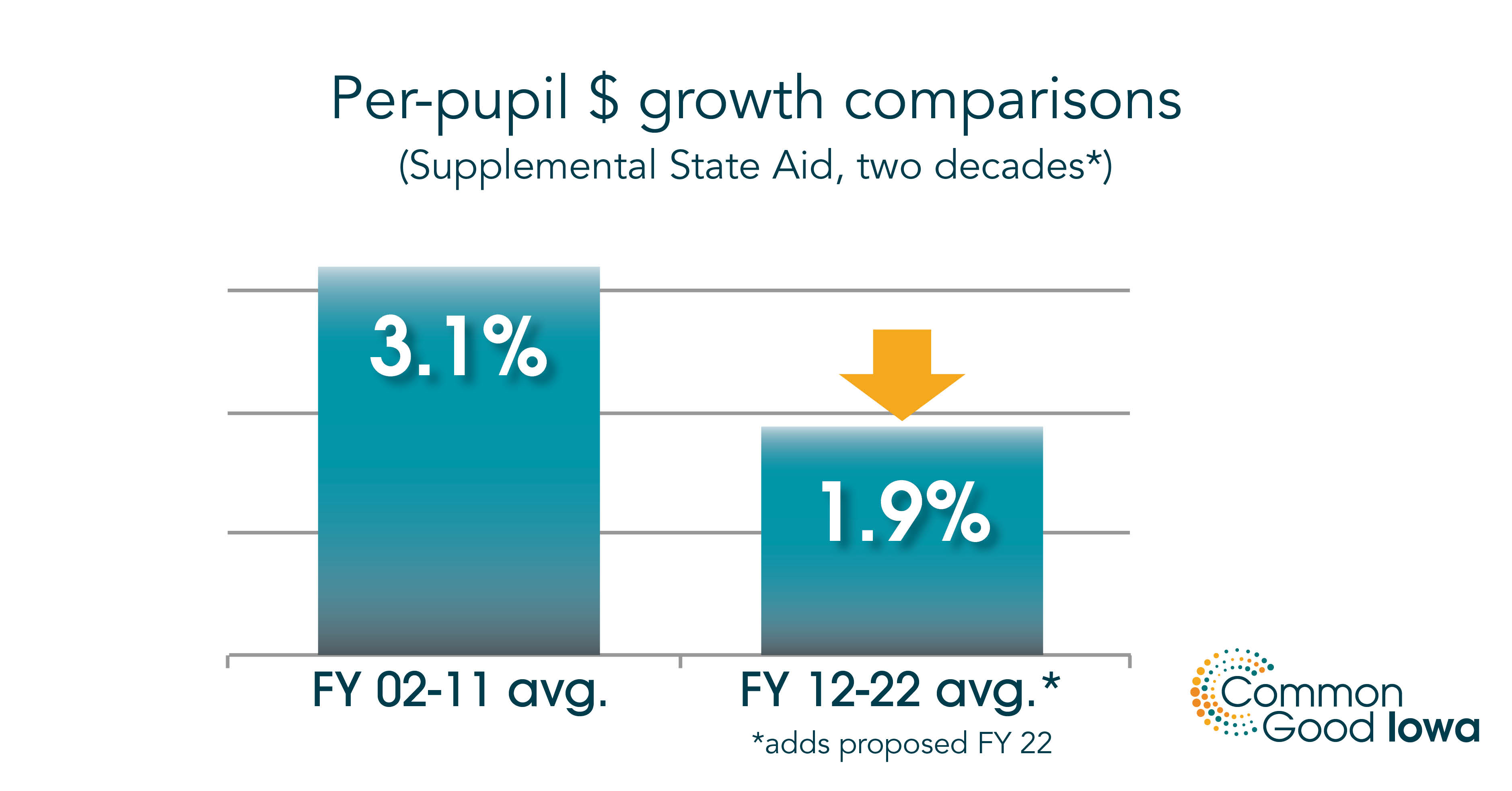When will Iowa stop eroding its foundation in education?
Posted on February 19, 2021 at 11:11 AM by Mike Owen
One of the most misunderstood and easily distorted statistics in Iowa political debate is what the state spends on K-12 public education. It is the biggest share of the state budget, so the numbers look large even when spending is cut or held below the increased costs. K-12 funding is complex, encompassing not only state funds but local and federal funds, and is subject to a formula designed to deliver equal educational opportunities no matter the ZIP code of the student.
Simple and honest measures to gauge these trends offer a check on political talking points. Chief among them is the basic building block of Iowa public-school funding: Supplemental State Aid (SSA), which governs per-pupil spending in each district’s regular program budget.
Supplemental State Aid is trending downward
The permitted level of per-pupil spending has been held far below costs for at least a decade — arguably longer, on average. SSA sets the percentage increase in the state cost per pupil assumed in a school budget. In FY 2021, that per-pupil figure — funded by both property tax and state aid — is $7,048 for 197 of Iowa’s 327 school districts, and ranges up to $7,203 for a handful of districts.[1] For FY 2019, lawmakers set the SSA percentage at its second-lowest level in 15 years: 1 percent, just one year after setting it at 1.1 percent. The 2.4 percent just approved by the Legislature for FY 2022 continues a weak response in recovering from those two exceedingly low years. As a result, SSA with that new level will be at 2 percent on average over the last 10 years, well below what is needed to keep up with costs. It would set the state cost per pupil at $7,227. 
The SSA percentage is the best single indicator of state policy on K-12 funding in Iowa. It governs what local districts can spend on their regular program, which includes administration and classroom costs, including teachers and support staff.
There are some wrinkles this year, however. Due to the COVID-19 pandemic, enrollments were down in the fall, which has an impact on districts because the funding formula is based on enrollment. When enrollments fall, even with a slight increase in the per-pupil funding level, on balance a district will have a smaller increase, and only for one year. This is known as the “budget guarantee.” A district is permitted in that circumstance to raise its previous year's funding by 1 percent — but that increase is totally on property taxes. Thus, when SSA percentages are set too low, it means a property tax increase. The Legislative Services Agency estimates 137 districts — well over one-third — will be in that situation for FY2022.
In addition, the COVID enrollment drop hit public preschool programs, which also are funded by state money and based on enrollment. LSA projects an 8.4 percent cut in funding for the Statewide Voluntary Preschool Program. Unlike regular K-12 school budgets, that preschool funding drop cannot be made up with property taxes. As a result, districts will be under financial pressure to reduce the number of preschool slots they offer.
Political spin about school funding
Funding of local public schools has increased; so have schools’ costs. In addition, the way schools are funded — with a mix of state and local tax dollars — can confuse perceptions about what the state is actually doing for public education. Political claims about state funding of schools frequently cloud the fact that a shift from local to state funding — property tax cuts, state funding increases — can leave schools with no or little real increase.[2] This is especially the case in districts with declining enrollment.
In other words, dollar amounts in state aid do not tell the whole picture of school funding — but all of it is under control of the state Legislature and Governor, because they set the cost per pupil and SSA percentage that a district uses to build its budget.
[1] Iowa Department of Management, District Cost Per Pupil FY2021, https://dom.iowa.gov/document/district-cost-pupil-fy2021
[2] See Iowa Fiscal Partnership, Get facts on school funding, Jan. 8, 2018, http://www.iowafiscal.org/get-facts-on-school-funding/
Categories: PK-12 schools

